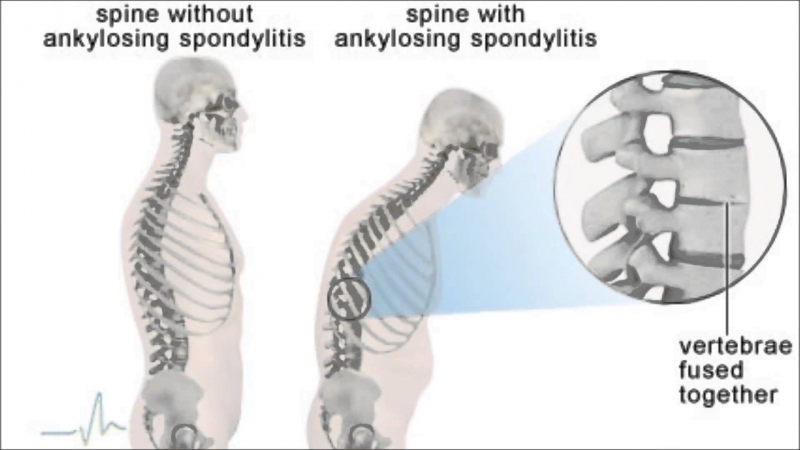
Ankylosing Spondylitis is a disease leading to some severe inflammation of the vertebrae. It is characterized by chronic pain and disability. Spondylitis is one of the common causes for back and neck pain, it occurs as a result of inflammation in the vertebral joints. Physiotherapy is the best treatment for Ankylosing Spondylitis in Gurgaon. Book your appointment at PAL Physiotherapy center, our professional and experienced physiotherapists helps the patient by doing exercises and stretches which improve the core muscle strength and stability. In some advanced stages of the disorder, the inflammation can cause the formation of a new bone on the spine resulting in deformity.
It is a kind of Arthritis primarily affecting the spine of the patient. The disorder often leads to the fusing of some of the vertebrae in the spine. This fusing results in a reduced flexibility of the spine. Further, it can make the posture hunched-forward. In case the ribs of the patient are affected or involved, it can get extremely difficult to breathe deeply.
The disorder is spotted more commonly among the men rather than the women. Signs and symptoms start appearing at the onset of adulthood. Inflammation occurs in other parts of the body such as the eyes.
No specific cure has been discovered yet for Ankylosing Spondylitis. However, certain approaches towards the treatment can alleviate the symptoms to a certain extent and slow down the progression of the disease. But physiotherapy for Ankylosing Spondylitis is the best option to heal your disorder. Make an appointment just dial 9811343417 and take best physiotherapy treatment.
The condition often causes pain and stiffness in other parts of the body of the patient. Sometimes, other large joints, like shoulders, hips, and knees, can be involved as well.
The exact cause of Ankylosing Spondylitis is not known yet. Some popular texts propose that genetic factors are responsible.
Generally, people having a gene called HLA-B27 are at an increased risk of developing the disorder. However, not all people with the gene develop the condition.
There are no fixed signs and symptoms of Ankylosing Spondylitis as they vary from patient to patient depending on the factor triggering the condition. The condition, however, is generally characterized by a mild to moderate inflammation. The patients also report a complete absence of symptoms for some periods in between.
The most common symptom of the condition is a back pain in the morning and at night. This pain can also be experienced in the large joints, like the hips and shoulders.
Other commonly reported symptoms include -
Although it is primarily a condition of the spine, other parts of the body may be impacted too.
To begin with, a physical examination is conducted for the diagnosis. During the physical exam, the patient may be asked to bend in different directions. This is done to test the range of motion in the spine. The doctor may even try reproducing the pain by pressing on specific portions of the patient's pelvis or by moving the legs into a particular position. The patient may be asked to take a deep breath. This helps to evaluate if the patient has any significant difficulty expanding the chest or not.
Certain imaging tests like X-rays or MRI scan can be conducted to check for any changes in the joints and bones. However, these tests are not enough to unambiguously diagnose early forms of the disorder. The diagnosis of non-radiologic Axial Spondyloarthritis is, therefore, more tough and complicated. It is purely based on the presence of several typical features of the disease like -
No fixed cure for Ankylosing Spondylitis has been discovered yet. The treatment generally starts with dedicated sessions of physiotherapy held at regular intervals. The approach of the treatment is generally focused on alleviating the symptoms, reducing discomfort and improving function. Other goals of the treatment are to reduce pain and stiffness along with maintaining a good posture and preventing any deformity. Regular physiotherapy sessions can preserve the patient's ability to perform normal activities.Book your daily physiotherapy classes at PAL Physiotherapy Clinic. We provide physiotherapy for Ankylosing Spondylitis in Gurgaon to cure your injury.
If the condition is treated properly, patients with Ankylosing Spondylitis can be able to live a normal life.PAL Physiotherapy one of the best physiotherapy clinic in Gurgaon having qualified physiotherapist, the patient must consult them for personalized treatment plan designed at the earliest.. The general goals and expected outcomes of a physiotherapy treatment for the disorder are -
The patient should get started with physical and occupational therapy on time as it is important to maintain function and minimize deformity. A well-planned routine of daily exercises helps reduce stiffness and strengthens the muscles around the joints while preventing or minimizing a potential risk of disability. Deep breathing exercises must be a part of the schedule as they help keep the chest cage flexible. Swimming is another recommended exercise. Some other therapeutic exercises include -
